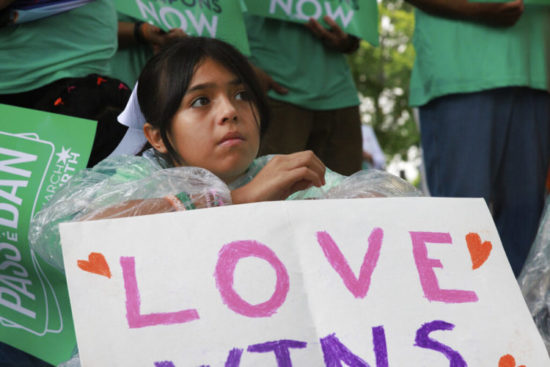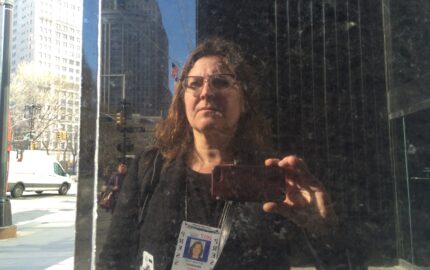By Jacqui Banaszynski
My fingers felt heavy on the keyboard last week as I edited two special posts that were long in the making. The posts themselves explore the kind of craft tools and inspiration — the partnership of mechanic and muse — that is the core of Storyboard's mission. The featured journalists described their techniques, choices and struggles in tackling the most sensitive of stories. As I read behind-the-scenes pieces like this, I imagine reporters opening their notebooks and letting us peek into a process that is professional but also deeply personal. They are a generosity I never take for granted and, after four-plus decades in the field, still learn from.
So why the heavy fingers? A direct reflection of a heavy heart. The posts both focused on the scourge of gun violence in America. More specifically, they unravel the work behind two stand-out pieces — one by Rick Rojas and a team at The New York Times, the other by John Woodrow Cox of The Washington Post — about the shooting at Robb Elementary School in Uvalde, Texas, last May.
I almost typed "massacre" instead of shooting, and it would not have been inappropriate: 19 children and two teachers, dead. Uvalde now holds the unwelcome distinction of being home to the second-worst mass shooting at a school, behind Sandy Hook Elementary in Newtown, Connecticut, where 20 first-graders and six faculty were killed in 2012. These are, without question, massacres. But we all find emotional buffers, I suppose, and the rawness of that word makes me cringe.
So the subject of the posts was challenging enough. But the final edit came as we were assaulted once again by a new rash of mass shootings last week — three in California that left 19 dead, another in eastern Washington where a shooter took three lives before he killed himself. The latter might not even meet the official media standard of a mass shooting, which often is defined as four or more deaths or injuries from a single event; some counts include the shooter, others don't.
This is somehow what it has come to: the need for a threshold to determine which gun deaths warrant our attention. This is also what it has come to from a story last week in The New York Times about mass shootings in the U.S. in 2023:
Last Friday, as my fingers slogged across the keyboard trying to make sense of this for the newsletter, NPR reported that the number of mass shootings now stands at 40. I haven't found details. I am reluctant to hunt very hard, especially as I try to absorb the dark news about the death of Tyre Nichols under the boots and batons of Memphis police.
I fear this isn't the best way to inspire you to read our posts on the Uvalde school schooting. It feels like a long-winded content warning: These posts include explicit passages about trauma and violence that some readers may find upsetting. There was no plan to run these posts the same week as we, in these dis-United States, absorb news of this most recent spate of slaughter. It was simply a heartbreaking serendipity.
As is the fact that Rojas' piece in the Post focuses on the family of Jackie Cazares, who was killed in the shooting at Robb Elementary, while Cox profiles Caitlyne Gonzales, who survived and became the public voice of her classmates — often portrayed by the media in ways that misunderstood the true trauma. The sad serendipity: Jackie and Caitlyne were best friends.
But please take a deep breath and dive in. There is so much to learn about how the best journalists approach the kinds of stories that shouldn't be necessary to write — but are.
* * *
A version of this post was first published as a Nieman Storyboard newsletter on Jan. 27, 2023.
My fingers felt heavy on the keyboard last week as I edited two special posts that were long in the making. The posts themselves explore the kind of craft tools and inspiration — the partnership of mechanic and muse — that is the core of Storyboard's mission. The featured journalists described their techniques, choices and struggles in tackling the most sensitive of stories. As I read behind-the-scenes pieces like this, I imagine reporters opening their notebooks and letting us peek into a process that is professional but also deeply personal. They are a generosity I never take for granted and, after four-plus decades in the field, still learn from.
So why the heavy fingers? A direct reflection of a heavy heart. The posts both focused on the scourge of gun violence in America. More specifically, they unravel the work behind two stand-out pieces — one by Rick Rojas and a team at The New York Times, the other by John Woodrow Cox of The Washington Post — about the shooting at Robb Elementary School in Uvalde, Texas, last May.
I almost typed "massacre" instead of shooting, and it would not have been inappropriate: 19 children and two teachers, dead. Uvalde now holds the unwelcome distinction of being home to the second-worst mass shooting at a school, behind Sandy Hook Elementary in Newtown, Connecticut, where 20 first-graders and six faculty were killed in 2012. These are, without question, massacres. But we all find emotional buffers, I suppose, and the rawness of that word makes me cringe.
So the subject of the posts was challenging enough. But the final edit came as we were assaulted once again by a new rash of mass shootings last week — three in California that left 19 dead, another in eastern Washington where a shooter took three lives before he killed himself. The latter might not even meet the official media standard of a mass shooting, which often is defined as four or more deaths or injuries from a single event; some counts include the shooter, others don't.
This is somehow what it has come to: the need for a threshold to determine which gun deaths warrant our attention. This is also what it has come to from a story last week in The New York Times about mass shootings in the U.S. in 2023:
By the start of the fourth week in January, the tally had grown to include at least 39 separate shootings in which four or more people were injured or killed, according to the Gun Violence Archive, outlining a striking explosion of violence across a range of sites in nearly every corner of the nation that killed at least 69 people.
Last Friday, as my fingers slogged across the keyboard trying to make sense of this for the newsletter, NPR reported that the number of mass shootings now stands at 40. I haven't found details. I am reluctant to hunt very hard, especially as I try to absorb the dark news about the death of Tyre Nichols under the boots and batons of Memphis police.
I fear this isn't the best way to inspire you to read our posts on the Uvalde school schooting. It feels like a long-winded content warning: These posts include explicit passages about trauma and violence that some readers may find upsetting. There was no plan to run these posts the same week as we, in these dis-United States, absorb news of this most recent spate of slaughter. It was simply a heartbreaking serendipity.
As is the fact that Rojas' piece in the Post focuses on the family of Jackie Cazares, who was killed in the shooting at Robb Elementary, while Cox profiles Caitlyne Gonzales, who survived and became the public voice of her classmates — often portrayed by the media in ways that misunderstood the true trauma. The sad serendipity: Jackie and Caitlyne were best friends.
But please take a deep breath and dive in. There is so much to learn about how the best journalists approach the kinds of stories that shouldn't be necessary to write — but are.
* * *
A version of this post was first published as a Nieman Storyboard newsletter on Jan. 27, 2023.



